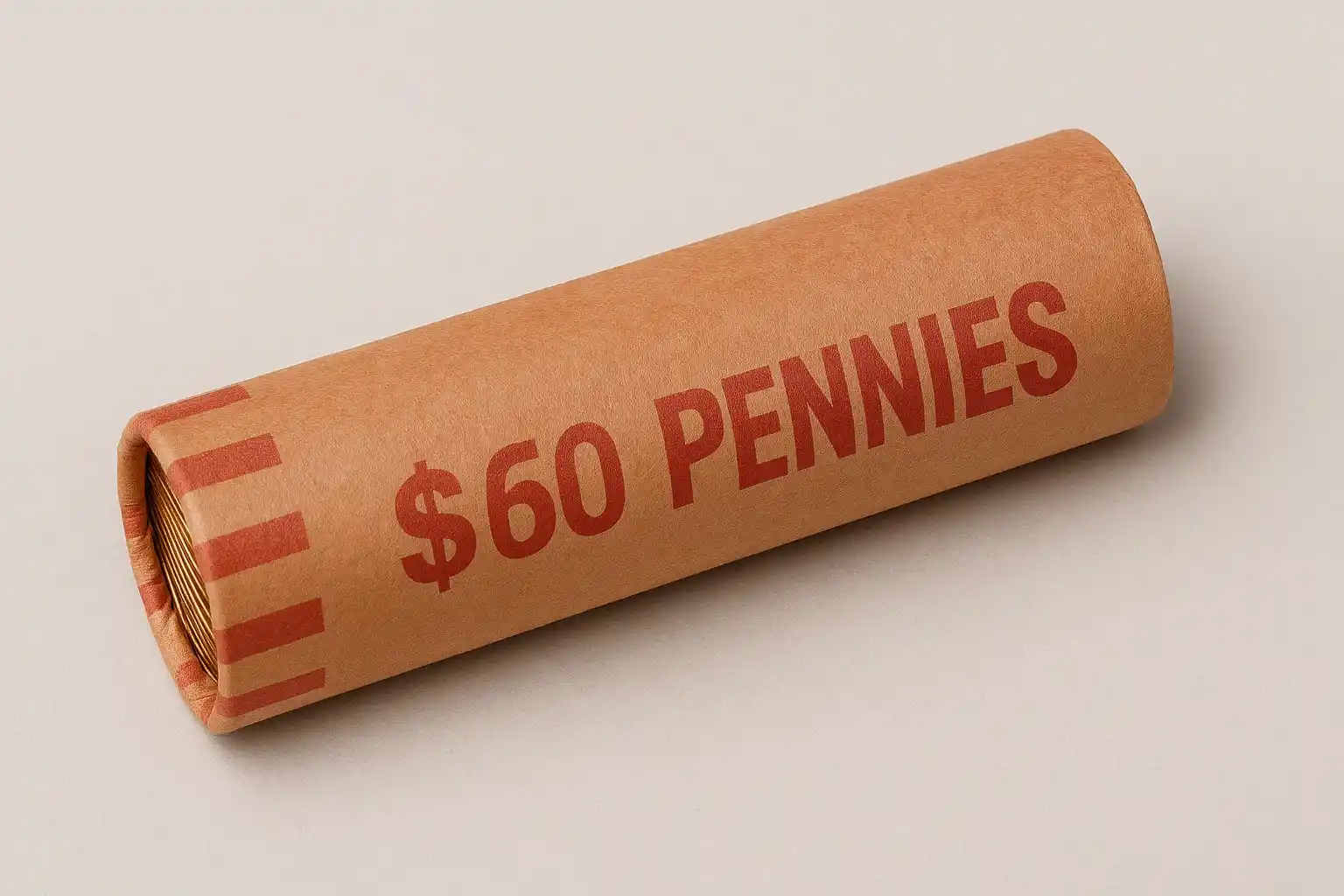When you hand over cash at a store or receive change at a bank, you may notice neat cylinders of coins stacked on counters or tucked into drawers. These are coin rolls—a simple way to organize small change. There are rolls for each denomination, e.g., roll of nickels, pennies, dollars, dimes, etc.
They have an obvious role in banking and retail, but they’ve also taken on a second life as specialties for collectors who hope to find rare or valuable pieces hidden inside.

The Origins of Coin Rolls
Coin rolls began appearing in the late 19th and early 20th centuries as banking systems modernized. Before that, coins were often stored in canvas bags or wooden boxes, making handling inefficient. Wrapping coins in paper sleeves became a lightweight, standardized method to count, distribute, and transport them.
Over time, banks, the U.S. Mint, and private coin processors adopted mechanical wrapping systems. This ensured consistency: every roll of nickels, quarters, or dimes held the same number of coins and the same face value. That predictability made coin rolls indispensable for businesses and households alike.
Standard U.S. Roll Counts
Each denomination has a fixed count. Here’s the breakdown used in the United States:
Denomination | Coins per Roll | Face Value |
Pennies | 50 | $0.50 |
Nickels | 40 | $2.00 |
Dimes | 50 | $5.00 |
Quarters | 40 | $10.00 |
Half Dollars | 20 | $10.00 |
Dollar Coins | 20 | $20.00 |
The same structure applies across all banks, so that rolls are interchangeable and reliable.
International Standards
Other countries follow similar systems, though the counts and face values vary:
Canada: 50 pennies (now discontinued), 40 nickels ($2), 50 dimes ($5), 40 quarters ($10), 20 loonies ($20), 25 toonies ($50).
Eurozone: Each euro coin has its own roll size. For example, €2 coins are rolled in 25s (€50 per roll), while €1 coins are rolled in 25s (€25 per roll).
United Kingdom: £1 coins are often rolled in 25s (£25 per roll), while 50p coins are usually in 20s (£10 per roll).
These standards make banking systems efficient worldwide, but they also add variety for international collectors.
Types of Coin Rolls
Not all coin rolls are the same. Collectors and businesses often distinguish between several categories:
Bank-Wrapped Rolls
Produced by mints or commercial coin-wrapping machines.
Ends are machine-crimped for security.
Often contain brand-new, uncirculated coins if purchased directly from the Mint.
Customer-Wrapped Rolls
Filled by people using paper sleeves.
Ends are folded by hand.
These rolls are a favorite for collectors, as they often contain older coins that people unknowingly deposit.
Plastic Tube Rolls
Favored by collectors for long-term storage.
Protect coins from moisture and handling damage better than paper.
Specialty Rolls
Released by mints or dealers.
May contain proof coins, commemorative issues, or limited-edition sets.
Sold at a premium over face value.

The Role of Coin Rolls in Daily Life
For banks and retail businesses, coin rolls are about efficiency. Instead of counting coins one by one, tellers can grab a roll knowing its exact value. Restaurants, vending companies, and stores use them to refill registers quickly.
For households, rolls are a way to turn jars of spare change into cashable bundles. Instead of carrying loose coins to a bank, families can wrap them and exchange them for bills.
Coin Roll Hunting
For collectors, coin rolls offer something far more exciting: the chance to find hidden value. This practice, known as coin roll hunting, has grown popular in recent decades. Hobbyists request rolls of coins from banks, open them, and check each coin for special traits.
What Collectors Look For:
Silver content: Dimes, quarters, and half dollars minted before 1965 contain 90% silver. Even circulated examples are worth more than face value.
Rare dates: Some years had very low mintages. A well-known example is the 1950-D Jefferson nickel, which is often searched for in rolls.
Mint errors: Coins with double dies, off-center strikes, or die cracks can be highly valuable.
High-grade examples: Even common dates can command strong prices if found in near-mint condition suitable for grading.
Specialty and Commemorative Rolls
Mints occasionally release special rolls for collectors. In the U.S., examples include rolls of State Quarters, America the Beautiful Quarters, and the ongoing American Women Quarters series. These rolls often contain freshly struck, uncirculated coins and are packaged for collectors rather than circulation.
Tips for Handling and Storing Coin Rolls
Use gloves when handling coins to prevent skin oils from damaging surfaces.
Avoid cleaning coins, as cleaning can reduce value.
Label rolls clearly if storing for long periods. Include denomination, year ranges, and any notable finds.
Store in stable conditions—cool, dry environments protect coins from tarnish and corrosion.
Collectors often prefer plastic tubes over paper, as tubes resist moisture and accidental tearing.
Coin Rolls as Historical Snapshots
Every roll can tell a story. A roll of wheat pennies might include coins from the 1910s alongside pieces from the 1950s, reflecting decades of circulation. A roll of quarters may contain designs from different U.S. states, offering a miniature tour of history and geography.
Original, unopened rolls from past decades are especially valuable. These rolls act as time capsules, containing untouched coins in the condition they left the mint. A bank-wrapped roll from the 1950s, for example, can be worth far more than the face value of the coins inside.
Coin rolls are one of the simplest tools in finance, yet they carry outsized significance. For businesses, they ensure efficiency. For households, they turn loose change into organized money. For collectors, they are opportunities—sometimes containing silver, rare dates, or mint errors that transform pocket change into prized collectibles.

